| Pages:
1
2 |
MrHomeScientist
International Hazard
    
Posts: 1806
Registered: 24-10-2010
Location: Flerovium
Member Is Offline
Mood: No Mood
|
|
Calcium Sulfate and Titanium Thermite
For the last few weeks, I’ve been trying to follow blogfasst25’s procedure (outlined on his blog: http://developing-your-web-presence.blogspot.com/2008/10/on-... ) for making titanium thermite. In this composition, a heat booster is required to
keep the reaction going and to ensure the products are all molten (necessary for good metal/slag separation). He uses calcium sulfate and extra
aluminum powder. I have had some troubles getting this to work properly, and I thought I’d post the details of my efforts in case others have had
the same issues.
My source for calcium sulfate was DAP brand plaster of paris, which is the hemihydrate (CaSO4 * 1/2H2O). The ingredients listed on the back are
calcium sulfate, calcium carbonate, and silicon dioxide. Assuming the latter two were only there in small amounts, I set off using this plaster
straight out of the box. After heating some of it in my oven for 2 hours at 425 F to dehydrate it, I mixed up a batch of thermite according to
blogfast’s specs:
TiO2 – 30g
CaSO4 – 25.5g
Al – 27g
CaF2 – 17.5g
Here’s how it went: http://www.youtube.com/watch?v=KfqKOaZyllQ
That video is actually my second try, which used the extra booster formula (see the video’s description for specifics). As you can see, the burn was
very “sputtery.” While it did produce titanium metal, the pieces were small spheres that didn’t coalesce together like they should if the whole
thing were molten. The slag was also very sparkly throughout, likely from tiny pieces of Ti that were trapped before they could flow together. You can
see in the picture at the end spheres of white titanium embedded throughout the slag. Apparently the impurities, likely added as fire retardants or to
improve its setting properties, were more detrimental than I thought. Here’s the Ti I recovered from this batch:
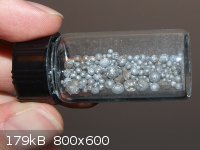
I looked up the MSDS for this particular brand of plaster: http://www.dap.com/docs/msds/00071008_english.pdf
Turns out, the impurities are pretty significant – CaCO3 at 15% – 25%, and SiO2 at 0% - 1%.
So, to remedy this I tried removing some of the additives. The silica isn’t worth the effort needed to remove it, but the CaCO3 is easy enough to
destroy with a treatment in acid. As a bonus, by using sulfuric acid I make more of my desired reagent!
CaCO3 + H2SO4 == CaSO4 + H2O + CO2
I took some of the raw plaster, submerged it in a good amount of water (so it wouldn’t harden up on me), and added roughly 9M sulfuric acid slowly
until the bubbling stopped. I filtered off the CaSO4, let it air dry, and then dehydrated the powder in a fused silica crucible over my small butane
burner for about 45 minutes. Using this in the same thermite composition listed above, the reaction ran much smoother: http://www.youtube.com/watch?v=DSY4biEB88Y
When recovering the metal afterward, the pieces were much larger and I found 4 or 5 individual pieces about ½” in diameter. This is indicative of a
much better reaction temperature, but there were still some problems with this batch. There were a number of large voids in the slag, the Ti metal was
incredibly hard to separate from the adhering slag, and the metal pieces were much more tarnished.
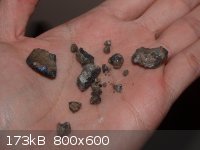
My hypothesis is that all of these are due to water of crystallization still in the CaSO4, i.e. I didn’t heat it up enough. The water boiling off
would cause the voids, and I suspect it would react with the hot Ti metal to tarnish its surface. The tarnish can be easily polished off, of course,
but I feel that I can do better.
=====================
My next attempt was to make my own CaSO4, so I know it’s pure (or at least, I know for certain what’s in it!) I tried two methods to do this.
Method 1: CaCl2 + H2SO4 == CaSO4 + 2HCl
This uses calcium chloride and sulfuric acid, both of which are fairly OTC for me – CaCl2 is used in Damp Rid brand moisture absorbers, and my
sulfuric acid is from Liquid Fire brand drain opener. It also produces hydrochloric acid as a byproduct, so this might be a handy way to get much
higher purity acid than hardware store brand muriatic acid (which is highly contaminated with, mostly, iron).
Method 2: MgSO4 + CaCl2 == CaSO4 + MgCl2
I like this method a lot because it uses nothing hazardous at all, and both reactants are very easy to source: magnesium sulfate is Epsom salt and
calcium chloride is used in Damp Rid.
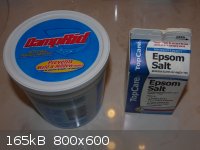
I tried both methods, and they both work exceedingly well. As long as you use dilute solutions of everything (mine were <5M), the precipitation
doesn’t happen immediately. That means it is much less likely to form occlusions of impurities and you end up with a beautifully snow white product.
I then heated both samples to 480F for two hours to dehydrate – here they are fresh out of the oven:
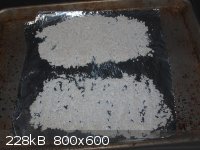
The Method 2 sulfate is on top, and Method 1 on bottom. The latter was quite a bit more powdery and a little purer white, which is interesting
considering it was made from acid that has a dark red color to it.
I was able to use all the sulfate from Method 2 for a single 100g Ti thermite charge. The result can be seen here: http://www.youtube.com/watch?v=6TFty76NyHw
This one was a little slow to start, but burned fairly well once it got going. The slag was especially nice, conforming to the bottom of the flower
pot very nicely with only one small void – meaning it was completely molten and (mostly) free of water. The pieces I recovered were about halfway
between the first two reactions – larger spheres than the first run with their somewhat shiny cast, but smaller than the lumps of the second.
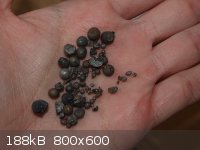
So that’s where I’m at now. Ideally, I want to produce large, shiny lumps of Ti for my element collection, but I think these will do nicely for
now. If anyone else is trying this reaction, I hope my posting my efforts here was helpful!
|
|
|
blogfast25
International Hazard
    
Posts: 10562
Registered: 3-2-2008
Location: Neverland
Member Is Offline
Mood: No Mood
|
|
Very nice work and write-up, MrHS, thank you. I'm convinced the formulation needs a little more CaSO4/Al booster, just giving it that extra bit of end
temperature to operate in your 'local conditions'. Let me come up with a suggestion tomorrow.
[Edited on 28-8-2012 by blogfast25]
|
|
|
elementcollector1
International Hazard
    
Posts: 2684
Registered: 28-12-2011
Location: The Known Universe
Member Is Offline
Mood: Molten
|
|
Are you kidding?! Those Ti spheres look beautiful! Why wouldn't you use those as your element sample?
Elements Collected:52/87
Latest Acquired: Cl
Next in Line: Nd
|
|
|
bbartlog
International Hazard
    
Posts: 1139
Registered: 27-8-2009
Location: Unmoored in time
Member Is Offline
Mood: No Mood
|
|
I think it's very interesting that the bits of Ti from the first run are so much shinier than those from the later, more productive trials. Is it
possible that the lower oxygen balance of that mix was the cause? If so you could try to tweak the formulation so that it's somewhere between the
first trial and the later ones (i.e. use slightly less than stoichiometric CaSO4) and see whether there is a happy medium to be found...
The less you bet, the more you lose when you win.
|
|
|
blogfast25
International Hazard
    
Posts: 10562
Registered: 3-2-2008
Location: Neverland
Member Is Offline
Mood: No Mood
|
|
MrHS:
Currently your [my] formulation is, in mol:
TiO<sub>2</sub> ……………….. 1 mol
Al ………………..2.666… (rec.) mol
CaSO<sub>4</sub> ……………… 0.5 mol
CaF<sub>2</sub> ………………… 0.6 mol
Which is perfectly stoichiometric for both reactions occurring.
My strong impression, weighing all the evidence before me, is that the formulation still runs a little too cool in your local conditions. I suggest to
increase the sulphate level by 0.1 mol (add 0.2666… mol Al also) or by 0.2 mol (add 0.5333… mol Al also). Higher end temperature allows more time
for the metal to coalesce before the melt freezes up. And a faster reaction gets all the chickens back in the henhouse faster, where they can
congregate and coalesce.
All in all the reaction in the video runs remarkably similar to my own, but mine have the edge in speed and smoothness, I think.
With CaSO4 I’ve always obtained globules though, whereas KClO3 does give slabs. I believe this is due to a surface tension effect.
With KClO3 I get metal that is as black as the ace of spades but it’s very, very superficial: buff the metal with a rotating steel brush (on a
drill) or such like; highly shiny, silvery metal will be yours.
Remind me again what ignition system you're using?
MrHS, ultimately to make the experience complete you’ll have to try KClO3 or KNO3/NaNO3 as booster systems!
[Edited on 29-8-2012 by blogfast25]
[Edited on 29-8-2012 by blogfast25]
[Edited on 29-8-2012 by blogfast25]
|
|
|
MrHomeScientist
International Hazard
    
Posts: 1806
Registered: 24-10-2010
Location: Flerovium
Member Is Offline
Mood: No Mood
|
|
elementcollector1: They do look beautiful, I agree! I would just love to be able to produce larger pieces of similar quality  I'll certainly be using them in the collection until I come across something better. I'll certainly be using them in the collection until I come across something better.
blogfast: Thanks for the advice. I need to make more sulfate, but once I do that I'll try it out with extra booster. Another thing that's bothered me
about this particular thermite is how clumpy the CaSO4 and, especially, the TiO2 can be. This makes it a little hard to mix fully, so my final mix
always has bits of white in it. That might lead to some of the sputter.
My ignition system is, essentially, Mg ribbon. What I do is make a 'volcano' of thermite, add a small pile of potassium permanganate to the top, and
push a piece of Mg ribbon into that so it just pokes out the top but also reaches down into the thermite. Adding glycerin causes it and the
permangante to ignite, which lights the Mg ribbon, which starts the thermite. I really like this method because it's worked every time, I don't have
to break out the blowtorch to light the ribbon, and it gives me ample time to walk away before the reaction starts.
I'd love to try those other boosters at some point, now that my understanding of thermite is starting to develop. I don't have any chlorate
unfortunately - what I need to do is look into making it via electrolysis (another subject that I don't know much about). I do have KNO3 - I'm
assuming these other boosters still react with excess Al, correct?
|
|
|
elementcollector1
International Hazard
    
Posts: 2684
Registered: 28-12-2011
Location: The Known Universe
Member Is Offline
Mood: Molten
|
|
All I have for my titanium piece is a spork. Granted, sporks are cool, but...
Also, I need someone's advice on my Al powder, as every thermite I've tried with it to date has failed. It's made from foil, and ball milled for a
while, and has that dark gray color (almost black) of German Dark. Is there something in the ingredients that causes the Al to be unreactive?
For chlorate, you almost certainly need a platinum, MMO, or lead dioxide anode. Add in a bunch of KCl, let run for a few days, and you should be
collecting crystals of chlorate in no time. Or, boil some bleach for sodium chlorate, and react with KCl to precipitate potassium chlorate (less
soluble). Recrystallize as necessary.
Elements Collected:52/87
Latest Acquired: Cl
Next in Line: Nd
|
|
|
blogfast25
International Hazard
    
Posts: 10562
Registered: 3-2-2008
Location: Neverland
Member Is Offline
Mood: No Mood
|
|
MrHS:
Yeah, TiO2 can be a bit lumpy. I always sieve off the lumps with a tea strainer. Set lumps aside for later use.
For a tested starting point formulation based on KNO3 boosting, replace the CaSO4 by KNO3, mol per mol.
Adjust the Al content slightly as follows:
1 mol CaSO4 uses 8/3 mol Al, so 0.5 mol uses 4/3 mol Al.
1 mol KNO3 uses 2 mol Al, so 0.5 mol uses 1 mol Al.
So reduce the overall Al content of the formulation by 4/3 – 1 = 0.333… mol.
EC1:
Ball milled or otherwise size reduced Al foil should be fine, not sure why yours doesn’t work. German Black has charcoal in it. Avoid for thermits.
[Edited on 29-8-2012 by blogfast25]
|
|
|
AndersHoveland
Hazard to Other Members, due to repeated speculation and posting of untested highly dangerous procedures!
    
Posts: 1986
Registered: 2-3-2011
Member Is Offline
Mood: No Mood
|
|
My experience is that magnesium/calcium sulfates make only very reluctant oxidizers in thermite mixtures. The oxygen seems to be held tightly within
the sulfate groups. Perhaps the reason is that the thermal decomposition point of sulfates are much higher than that for Fe2O3 or CuO. The sulfate may
mostly only be acting as an oxidizer in its molten phase, which is much less efficient than decomposing into oxygen gas that can pass outward and have
a higher surface area with the reducing metal powder.
Just because sulfates contain four atoms of oxygen does not mean they make good pyrotechnic oxidizers.
|
|
|
blogfast25
International Hazard
    
Posts: 10562
Registered: 3-2-2008
Location: Neverland
Member Is Offline
Mood: No Mood
|
|
Quote: Originally posted by AndersHoveland  | My experience is that magnesium/calcium sulfates make only very reluctant oxidizers in thermite mixtures. The oxygen seems to be held tightly within
the sulfate groups. Perhaps the reason is that the thermal decomposition point of sulfates are much higher than that for Fe2O3 or CuO. The sulfate may
mostly only be acting as an oxidizer in its molten phase, which is much less efficient than decomposing into oxygen gas that can pass outward and have
a higher surface area with the reducing metal powder.
Just because sulfates contain four atoms of oxygen does not mean they make good pyrotechnic oxidizers. |
As so often you talk baseless bullsh*t. Your label ‘Giver of bad advice’ remains apt. I sometimes wonder if your part here is to simply try and
disrupt things.
Compare any CaSO4 based booster system to more classic KClO3 or Na,KNO3 based system and there’s hardly a cigarette paper between them. I KNOW
because I’ve done it.
And simple stoichiometric mixtures of CaSO4 and Al powder burn like hell. I know because unlike you I’ve actually done it.
I’m convinced you have ZERO practical experience with such booster systems in thermits or elsewhere.
You’re an insufferable TWIT.
And here’s a very public warning: keep up with your charades and I will make a very convincing case to the mods for having you banned permanently
from this club. Capisce?
[Edited on 29-8-2012 by blogfast25]
|
|
|
elementcollector1
International Hazard
    
Posts: 2684
Registered: 28-12-2011
Location: The Known Universe
Member Is Offline
Mood: Molten
|
|
Can MgSO4 even be used in CaSO4's place?
I do believe the reason the Al is so very faulty is because, according to numerous sources, the foil is actually coated in plastic (making it useless
for melting). Perhaps I should melt some aluminum cans, then take a hacksaw to those.
Elements Collected:52/87
Latest Acquired: Cl
Next in Line: Nd
|
|
|
hyfalcon
International Hazard
    
Posts: 1003
Registered: 29-3-2012
Member Is Offline
Mood: No Mood
|
|
This is the aluminum I use in all my thermite/flash experiments.
http://alphachemicals.com/aluminum_powder
|
|
|
blogfast25
International Hazard
    
Posts: 10562
Registered: 3-2-2008
Location: Neverland
Member Is Offline
Mood: No Mood
|
|
Quote: Originally posted by elementcollector1  | Can MgSO4 even be used in CaSO4's place?
I do believe the reason the Al is so very faulty is because, according to numerous sources, the foil is actually coated in plastic (making it useless
for melting). Perhaps I should melt some aluminum cans, then take a hacksaw to those. |
Yes, MgSO4 would work too. But Epsom Salt is highly hydrated.
Al fois isn't coated plastic, AFAIK. There's no need: Al passifies; there's no need for further protection.
Are you sure your thermits are formulated properly?
|
|
|
MrHomeScientist
International Hazard
    
Posts: 1806
Registered: 24-10-2010
Location: Flerovium
Member Is Offline
Mood: No Mood
|
|
Quote: Originally posted by elementcollector1  | Can MgSO4 even be used in CaSO4's place?
I do believe the reason the Al is so very faulty is because, according to numerous sources, the foil is actually coated in plastic (making it useless
for melting). Perhaps I should melt some aluminum cans, then take a hacksaw to those. |
I don't believe Al foil is plastic coated, but I know soda cans are. There's the label on the outside, of course, but there is also a plastic lining
inside that prevents corrosion from the acidic soft drink. Melting the cans would probably burn off some of this and leave the rest as a slag, so you
should be alright going that route.
|
|
|
blogfast25
International Hazard
    
Posts: 10562
Registered: 3-2-2008
Location: Neverland
Member Is Offline
Mood: No Mood
|
|
Quote: Originally posted by MrHomeScientist  |
I don't believe Al foil is plastic coated, but I know soda cans are. There's the label on the outside, of course, but there is also a plastic lining
inside that prevents corrosion from the acidic soft drink. Melting the cans would probably burn off some of this and leave the rest as a slag, so you
should be alright going that route. |
Apparently the way it’s done industrially is to dunk the Al junk into a eutectic bath of KCl-NaCl. The molten Al sinks to the bottom (where it’s
regularly tapped off) and the paint, paper, plastic etc floats on top as dross which is periodically removed.
Melting down small amounts of Al is harder than you might think, as my experience showed. You need to get a bit of a bath going and because the molten
metal forms an oxide layer that can take a while to happen. But once you’ve got a few cm3 molten then you can feed small chunks into that and they
will melt like ice in water, if you keep heating the melt. Start with the cleanest metal you’ve got. Hammer down some Al foil balls for instance.
|
|
|
watson.fawkes
International Hazard
    
Posts: 2793
Registered: 16-8-2008
Member Is Offline
Mood: No Mood
|
|
Quote: Originally posted by blogfast25  | | Melting down small amounts of Al is harder than you might think, as my experience showed. [...] Start with the cleanest metal you’ve got. Hammer
down some Al foil balls for instance. |
In addition, heat the raw material to drive off residual and adsorbed
water. Water dissociates in molten aluminum. This reaction is driven by the relatively high solubility of H2 in molten aluminum. The oxygen
reacts forming alumina, a large component of slag. If you're casting aluminum, dissolved H2 is the dominant source of porosity.
You can also use fluxes when recovering Al in the backyard foundry. This page (found with a search) provides a reasonable introduction.
|
|
|
blogfast25
International Hazard
    
Posts: 10562
Registered: 3-2-2008
Location: Neverland
Member Is Offline
Mood: No Mood
|
|
Well, well, there's a whole world of fluxes out there!
|
|
|
CrossxD
Hazard to Self
 
Posts: 66
Registered: 6-7-2015
Member Is Offline
Mood: stainless
|
|
where I can find calcium fluride? or can I use other flux?
[Edited on 6-2-2016 by CrossxD]
|
|
|
j_sum1
Administrator
       
Posts: 6219
Registered: 4-10-2014
Location: Unmoved
Member Is Offline
Mood: Organised
|
|
I bought some from onyxmet for the purpose but have not used it yet. I didn't get much and it was a bit pricier than I would like.
The reaction definitely needs a flux. My last attempt did give me Ti but it was intermingled with everything else. You also need to dry the
hemihydrate calcium sulfate. Trying to drive off the water during the thermite reaction is enough of an energy burden to make a big difference to
your product.
blogfast25 is definitely the expert on this particular reaction. Although he was vague in his previous post and referring to Al recycling, I am
certain that he could recommend a few alternative fluxes for the thermite.
|
|
|
blogfast25
International Hazard
    
Posts: 10562
Registered: 3-2-2008
Location: Neverland
Member Is Offline
Mood: No Mood
|
|
Quote: Originally posted by j_sum1  |
blogfast25 is definitely the expert on this particular reaction. Although he was vague in his previous post and referring to Al recycling, I am
certain that he could recommend a few alternative fluxes for the thermite. |
The one to try is definitely quick lime - CaO. CaO and alumina form a number of low melting aluminates, aiding slag fluidity.
I tested this recently in the hardest of them all - MnO2 with 'good' results. I say 'good' in the sense that MnO2 thermites rarely give more than
30 % metal yield and the one with CaO flux did about the same.
It would be really interesting to test CaO in a TiO2/CaSO4 boosted formulation! 
Going by the Wikipedia entry, the lowest melting calcium aluminate is for a CaO/alumina molar ratio of about 2/1. But that would make for a very high
CaO loading. I think the optimal loading must be something like Al powder/CaO molar ratio between 4 and 2 in the thermite formulation.
<hr>
I don't see many other candidates as slag fluidizers in aluminothermy besides the trusted CaF2 and CaO. Slag fluidisers need to be inert
(irreducible by Al), very high BP and with an MP significantly below 2000 C, to be effective as fluxes. There's not that many compounds that jump to
mind, meeting those criteria.
[Edited on 6-2-2016 by blogfast25]
|
|
|
RogueRose
International Hazard
    
Posts: 1585
Registered: 16-6-2014
Member Is Offline
|
|
I'm doing something similar and have a question about the purity of my CaSO4. I suspect there is some NH4NO3 in it at at most 2.5% max concentration
of the CalSul. I wouldn't think this would cause any mayor problems as it seems that it should add some extra fuel but at a low enough concentration
that it shouldn't pose any problem with causing an explosion of any kind.
could this cause any problems with the mixture such as causing ignition or burn problems?
|
|
|
blogfast25
International Hazard
    
Posts: 10562
Registered: 3-2-2008
Location: Neverland
Member Is Offline
Mood: No Mood
|
|
Quote: Originally posted by RogueRose  | I'm doing something similar and have a question about the purity of my CaSO4. I suspect there is some NH4NO3 in it at at most 2.5% max concentration
of the CalSul. I wouldn't think this would cause any mayor problems as it seems that it should add some extra fuel but at a low enough concentration
that it shouldn't pose any problem with causing an explosion of any kind.
could this cause any problems with the mixture such as causing ignition or burn problems? |
Not in my opinion.
|
|
|
careysub
International Hazard
    
Posts: 1339
Registered: 4-8-2014
Location: Coastal Sage Scrub Biome
Member Is Offline
Mood: Lowest quantum state
|
|
I see it on eBay for not unreasonable prices.
People use sodium fluoride as a flux, which is available cheap from pottery supply places.
If calcium fluoride it must be, you could make it by dissolving the sodium fluoride in water and precipitating with a soluble calcium salt (calcium
chloride, perhaps).
BTW: I will point out (form early comments on this thread) that most plaster-of-paris compositions (and DAP in particulare) are 25% calcium carbonate,
not an insignificant amount.
[Edited on 6-2-2016 by careysub]
|
|
|
blogfast25
International Hazard
    
Posts: 10562
Registered: 3-2-2008
Location: Neverland
Member Is Offline
Mood: No Mood
|
|
Quote: Originally posted by careysub  |
People use sodium fluoride as a flux, which is available cheap from pottery supply places.
If calcium fluoride it must be, you could make it by dissolving the sodium fluoride in water and precipitating with a soluble calcium salt (calcium
chloride, perhaps).
BTW: I will point out (form early comments on this thread) that most plaster-of-paris compositions (and DAP in particulare) are 25% calcium carbonate,
not an insignificant amount.
|
NaF, with a BP of about 1700 C simply boils off in Thermites.
NaF is poorly soluble, about 1 M limit, so not ideal for that purpose.
My no-frills wall-filler contained no CaCO3 whatsoever. It's easy to test for and easy to remove, if needed.
|
|
|
careysub
International Hazard
    
Posts: 1339
Registered: 4-8-2014
Location: Coastal Sage Scrub Biome
Member Is Offline
Mood: Lowest quantum state
|
|
I'm not sure that is such a problem since the desired product is the precipitate.
I have had problems trying to do metathesis with more concentrated solutions (ammonium sulfate and calcium nitrate) where a massive unworkable
water-holding precipitate formed. The recommendation I encountered there was to use a much more dilute solution (and which made it much less
attractive since the product remained in solution).
A gallon of water would dissolve 160 grams of sodium fluoride, yielding 210 grams of CaF2. Mix it up in an old 1 gallon milk jug and put it aside to
settle seems pretty easy to me. Do it as often as needed to make more.
|
|
|
| Pages:
1
2 |